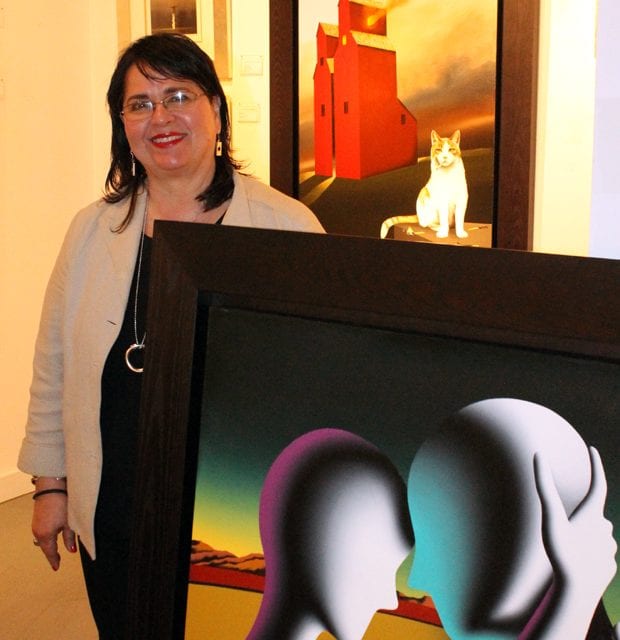Out fine art consultant Sylvia Wilkins shares her tips for acquiring home beauty

Sylvia Wilkins describes Martin Lawrence Galleries as a hidden gem of Dallas art, offering unique works from Picasso and Warhol, as well as mainstay Robert Deyber, rear, and favored new acquisitions from legendary Mark Kostabi, front.
Photography by Arnold Wayne Jones.
SCOTT HUFFMAN | Contributing Writer

Acquisition of fine art is often perceived as a luxury. The limited availability and irreplaceable nature of such art — two aspects that make it appealing and valuable — can create an environment ripe for both risk and reward. As a result, the purchase of an original painting, a limited edition print or a freestanding sculpture can be an intimidating venture for novice collectors and experienced art traders alike.
Sylvia Wilkins, an out art collector and senior fine art consultant with Martin Lawrence Galleries in Dallas, is an expert at pairing budget, client and artwork. (She estimates at least 20 percent of her clientele is LGBT.) She agreed to share a few tips to consider when purchasing fine art, regardless of you budget or experience.
Allure. The notion that beauty is in the eye of the beholder is perhaps never truer than when buying fine art. The works we display in our homes should be something that we love — and, more importantly, enjoy. It should also reflect our personalities. “It’s the one thing that people may not realize,” Wilkins says. “It’s even more personal than the clothing that you buy. You are defining yourself by the art that you have.”
Wilkins advises potential buyers to view as much art as possible prior to making an initial purchase. Become familiar with a wide range of styles and media. A current market trend, for example, is graffiti art (a la Banksy and Mr. Brainwash). Also gaining popularity is the work of out artist Robert Deyber, who specializes in witty visualizations of language. “Look at a lot of art, and look at it more than once,” Wilkins advises. “Art is a process. It’s like eating food for the first time. You don’t always have the pathways in your brain yet [to appreciate it].”
Investment. Investment in fine art is limited only by the depth of one’s pockets. Yet not all art has to be expensive to be fine. Indeed, Wilkins believes there are instances in which a buyer should feel comfortable worrying more about his or her personal connection to a piece rather than with its value.
As a rule, Wilkins advises starting with a threshold for impulse buys — say, $5,000. “If you are out somewhere and you see some art and it’s less than $5,000, then buy it,” Wilkins says. “It’s worth it because it moved you.” Transactions in greater amounts, however, will probably involve some due diligence to validate the initial cash outlay.
Condition. When evaluating fine art, condition is perhaps the chief element influencing price. The better the condition, the greater its worth. Wilkins recommends viewing prospective pieces unframed whenever possible, which allows one to inspect for common condition issues including fading, repairs or alterations.
In the current market, pristine pieces from highly collectible artists are becoming more difficult to find. “When you are looking at blue chips, we probably pass on about 70 percent of the things that go to Sotheby’s and Christie’s,” Wilkins says. “Everything [for the gallery] has to be perfect.”
Research. As anyone who has watched Antiques Roadshow knows, provenance is critical when evaluating fine art. Wilkins recommends that buyers request historical documents, like certificates of authenticity and bills of sale connected to the piece. She also suggests looking at the backsides of artwork for labels, markings and other clues of historical significance. “There [can be] a lot of information on the back,” she says. “Is it signed? Is it numbered?”
Authentication of highly collectible pieces can be key as well. Experienced dealers will generally inspect such works and then match their findings to information recorded in an artist’s catalogue raisonné — a task which helps to prove a piece has not been forged or altered. “The acquisition price may be a little higher,” Wilkins says of authenticated art, “but you are buying the peace of mind that the curating efforts provide.”
Recourse. Wilkins recommends buying fine art from reputable dealers — if not just for their market experience, then for an increased likelihood of recourse in the event a piece turns out to be something less than anticipated. “You want to buy it from a place that has a lot to lose if [the piece] isn’t what they say it is,” Wilkins says. “You want to do business with people who have been in business for a long time.”
Wilkins also discourages purchasing art that one has not viewed in person. She likens the electronic procurement of art to online romance. “Buying art over the Internet is like dating over the Internet,” she jokes. “You don’t always get what you signed up for.” For those who choose to purchase art online, Wilkins recommends making sure the dealer’s return policy allows ample time for authentication of the work.
Enjoyment. Ultimately, art is meant for viewing. And selecting pieces wisely will result in a lifetime of enjoyment. “Every piece has a history,” Wilkins says. “You buy it, and it then becomes a part of your history.”
This article appeared in the Dallas Voice print edition April 24, 2015.

